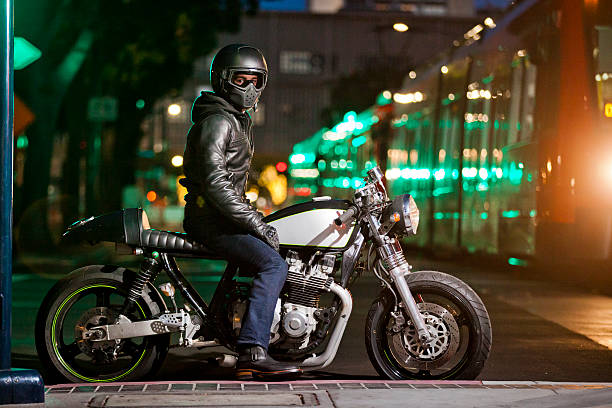Riding in Winter: Insulated Leather Vests
Riding a motorcycle doesn’t have to be a fair-weather hobby, especially not with the right gear. A leather biker vest for winter is a perfect blend of style and functionality, offering warmth without sacrificing the essence of biker fashion. As temperatures drop, the need for insulated leather vests becomes paramount for riders who refuse to let the cold interfere with their passion for the open road.

The key to a great winter leather vest lies in its insulation. Modern advancements in clothing technology have led to the development of lightweight, yet highly effective insulating materials. These materials trap body heat, keeping the rider warm in chilly conditions, while still maintaining the vest’s sleek profile. The beauty of insulated leather vests is their ability to provide warmth without the bulkiness often associated with winter gear.
When selecting an insulated leather vest, the type of insulation is an important consideration. Synthetic insulations, such as Thinsulate, are popular due to their ability to retain heat even when wet. Natural down is another option, known for its exceptional warmth and lightness, though it can be less effective if it gets damp. Some vests feature removable liners, offering the flexibility to adjust the level of warmth as needed, which is particularly useful in climates where temperatures can fluctuate throughout the day.
Winter vest functionality depends on its design. High collars warm the neck, which is often cold while riding. Insulated leather vests with adjustable waistbands or hem drawstrings keep heat in and drafts out. Pockets are essential for storage and cold-hand protection. Warm-lined pockets give cold protection.
Winter leather vests have grown from essential gear to attractive clothing that represent the rider’s personality. The black leather vest is traditional, but colors and patterns are becoming more popular. Embossed patterns, contrasting stitching, and colored leather panels give winter vests personality.
Winter riding requires layering, and a leather vest is ideal. Over sweaters, flannels, or lighter jackets, it adds warmth without impeding movement. Leather vests are versatile enough for riding and other cold-weather outdoor activities.
Durability is another reason winter leather vests are popular. Natural leather can survive rain, snow, and wind if properly kept. Leather vests are long-lasting, making them a good investment for your riding gear.
Fit is crucial, especially for winter riding. A well-fitting vest is more comfortable and heat-retaining. It should be snug enough to keep warmth in yet loose enough for layering. Custom-fitted vests are available for folks who don’t fit normal sizes.
Sustainable options are available for eco-conscious riders. Sustainable leather, obtained and tanned sustainably, is growing in popularity. Some businesses make vests using synthetic leather, which looks and feels like real leather without the environmental impact.
An insulated leather biker vest for winter is crucial for riders. The leather vest’s classic shape and contemporary insulation technology provide warmth without sacrificing style or comfort. Insulated leather vests come in several shapes, designs, and materials to suit any rider. Even in freezing weather, a winter leather vest keeps you going on city streets or country roads.
Perfecting Winter Ride Layering
Braving the winter roads on a motorcycle requires more than just a passion for riding; it necessitates a strategic approach to attire, especially when it comes to layering. A leather biker vest for winter can be a central element of this strategy, offering both style and essential warmth. However, the key to comfort and protection against the cold lies in how you layer your clothing. Layering for winter riding is not just about piling on as many items as possible; it’s an art that balances warmth, mobility, and safety.
Cold protection begins with the base layer. The skin-contacting clothes’ main function is moisture management. You sweat while riding because you generate heat. Moisture on the skin can cause rapid heat loss. Quality base layers wick moisture from the skin to keep you warm and dry. Merino wool and specialist synthetics make great base layers. They’re moisture-wicking and toasty without being cumbersome.
The insulation-focused mid-layer follows. Your base layer generates body heat, which this layer retains to keep you warm. Popular mid-layers include fleece coats, down vests, and insulated shirts. Though lightweight, they’re warm. Weather severity and body insulation determine mid-layer thickness and material. This layer must be loose to trap air and keep you warm.
These layers are covered by the leather biker vest. Winter leather vests are heavier and may have insulation. Excellent windbreaker leather makes a great outer layer. It reduces wind chill, which can make biking cold. Some winter leather vests have high collars and long backs for increased warmth.
The extremities need gloves and socks. Since blood flow is concentrated away from your hands and feet in cold weather, they feel the chill first. To keep your hands warm and agile, wear waterproof insulated gloves. Insulated socks and sturdy riding boots help keep your feet toasty in frigid temperatures.
Other locations need treatment are your head and neck. Good balaclavas provide warmth and fit comfortably under helmets. It also shields your face from frigid air. To prevent cold air from going down your back, wear a neck gaiter or scarf, especially one that fits into your vest.
Winter cycling requires visibility, which clothing may provide. Winter days are shorter and fog or rain hinder visibility. Reflective components or high-visibility layers might make you more visible to drivers.
Winter riding layering also considers mobility. Excess layers might limit mobility and bike control. Each layer should fit snugly but not restrictively, enabling arm and leg motion. Staying warm and agile for safe riding is a tricky balance.
Finally, adaptation matters. Winter weather can change during your bike. Layering so you may add or delete objects is crucial. Example: A zipper on your mid-layer can control temperature without stopping and changing.
In conclusion, winter motorcycle riding requires proper layering. Using a moisture-wicking base layer, an insulating mid-layer, and a wind-breaking leather vest keeps you warm, dry, and safe. Protect your extremities, stay visible, move around, and adapt to changing situations. These layering suggestions can make winter rides safer and more fun. Despite the cooler road, clothing well can keep your riding passion alive.






Leave a Reply